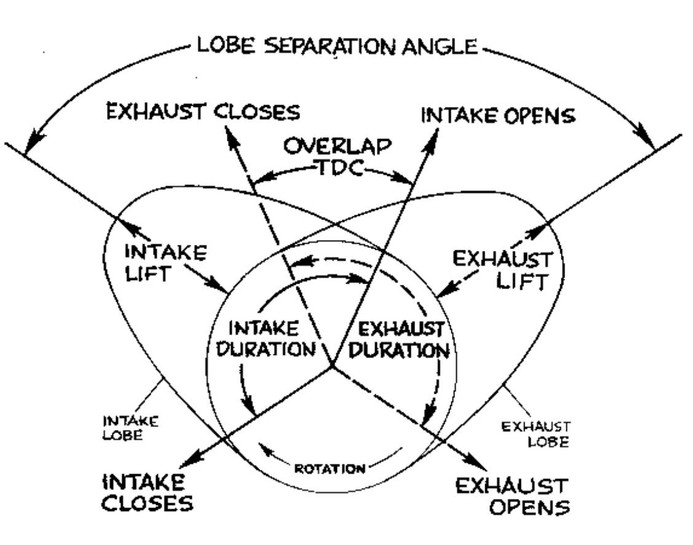Defining Lobe Center and It's Importance to Engine Performance: A Blog
While most of our customers know what lift and duration are, most are unfamiliar with the term Lobe Center and how it affects the engines performance. Making this the biggest obstacle to overcome when selecting a cam profile with one of our tech advisors, explaining the definition and importance of the Lobe Center.
Also know as Lobe Separation; Lobe Center is simply the distance between the peak opening points on the Intake and Exhaust lobes.
For Example: A 110-degree lobe separation means that the peak opening points of the Intake and Exhaust lobes is 110 degrees apart.
Lobe Separation or Lobe Centers is another way of expressing the Valve Overlap, which was the term formerly used by cam manufacturers before industry standard verbiage changed.
Overlap is the amount of time that both valves are open in the same cylinder.
All three terms are similar, as they all relate to the relationship between the centerline of the Intake lobe and the centerline of the Exhaust lobe.
Simply put, the lobe center of the camshaft controls where the power curve is applied.
The tighter the lobe center, the lower the RPM range; the wider the lobe center, the higher the RPM range.
A cam with a 112 lobe center will idle smoother than a cam with a 110 lobe center. While a cam with a 108 lobe center will idle rougher.
Tests have shown that, for a given cam profile, a tighter (smaller) lobe center will produce more average horsepower and a quicker revving engine. However it is at the expense of a small amount of bottom end power and idle quality, due to the increased overlap. In reality, a cam with 220º at 0.050" and a lobe center angle of 112 will have the exact same mechanical overlap as a cam with 217º at 0.050" and a lobe center angle of 109. If you compared these two cams side by side in identical engines, the first cam would actually have a slightly better idle and would produce slightly more peak power at upper RPM's. The second cam would have a rougher idle, produce more torque and would rev quicker.
Another related thought to consider when selecting a cam is inches of vacuum for your engine application when deciding upon a Lobe Center.
This may be of concern if you have vacuum assisted accessories, such as power brakes or steering.
A cam with a 112 lobe center will pull approximately 16-20" of vacuum, which is good for power brakes. A cam with 110 lobe center will pull approximately 14-18"of vacuum is borderline for that type of application. However, a cam with 108 will only pull 12-16", which is not enough for power assisted accessories.
These numbers can vary a few inches one way or the other, depending on several other aftermarket factors and your individual engine specifications, so you may want to check your vacuum once the cam is installed.
*If you do not have enough vacuum, you can in some cases install a vacuum canister or reservoir, which works by storing the peak vacuum in the reservoir. If that accessory still does not assist the cam in producing enough vacuum, then as a last resort you can use a vacuum pump.
When degreeing in the camshaft, you are making sure the intake centerline is precisely where the cam is intended to be. This is one of the many reasons why Clay Smith Cams always recommends degreeing your camshaft in using the Lobe Center Method. (You can find an instructional video of how to do just that on our Clay Smith Cams YouTube Channel; https://www.youtube.com/watch?v=57gfBu8uc6k&t=1s )
This is very critical for manifold vacuum, throttle response, emissions, and gas mileage.
If the intake valve opens too early, it will push the new charge into the intake manifold.
If it occurs too late, it will lean out the cylinder and greatly hinder the performance of the engine.
If the exhaust valve closes too early it will trap some of the spent gases in the combustion chamber, and if it closes too late it will over-scavenge the chamber and take out too much of the charge, again creating an artificially lean condition.
If the overlap phase occurs too early, it will create an overly rich condition in the exhaust port, severely decreasing the gas mileage.
For any additional clarification or questions please contact our Tech Line at 714 523-0530.

